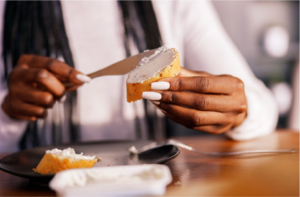Biceps or triceps?
We assume that retailers don’t want shopping carts to reduce spending?! But their design does not help: Pushing a shopping cart with a horizontal handle bar activates the triceps muscle which in turn inhibits the desire to buy products. A recent study compares this standard cart design with an alternative that features a parallel handle which activates our biceps muscle (see figure). 
In one of the study’s many experiments the authors compared choices of 194 shoppers with a standard shopping cart (horizontal handles) with the choices of 194 that used an alternative version with parallel handles. For these 388 shoppers, the scanning data of their purchases was analyzed.
Results show that the parallel handle shopping cart significantly outperformed the standard shopping cart in three ways:
- Quantity: Consumers shop a higher number of products – on average, they purchased 3.6 more SKUs
- Variety: Consumers on average choose 2.7 more unique products
- Spend: Consumers on average spent € 8.7 more
Also, consumers with the parallel handle cart purchased more of both vice (e.g., chocolate) and virtue (e.g., fruit) products, but less staple products (e.g., pasta, rice, flour).
From a retailer’s perspective, the shopping carts currently available underperform in terms of sales. In contrast, parallel handles on the cart increase sales in many categories. For consumers who worry about overconsumption standard handles may act as a useful budget restraint. With alternative shopping carts on the rise, consumers may well be advised to rely on shopping lists and/or mental budgeting to limit their spending!
Source: Estes, Z., & Streicher, M. C. (2021). Getting a Handle on Sales: Shopping Carts Affect Purchasing by Activating Arm Muscles. Journal of Marketing.


















































































































































































































































































































































































































































